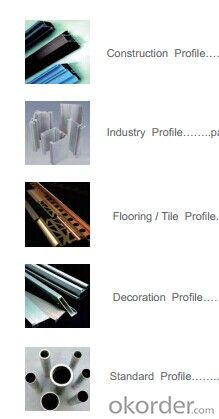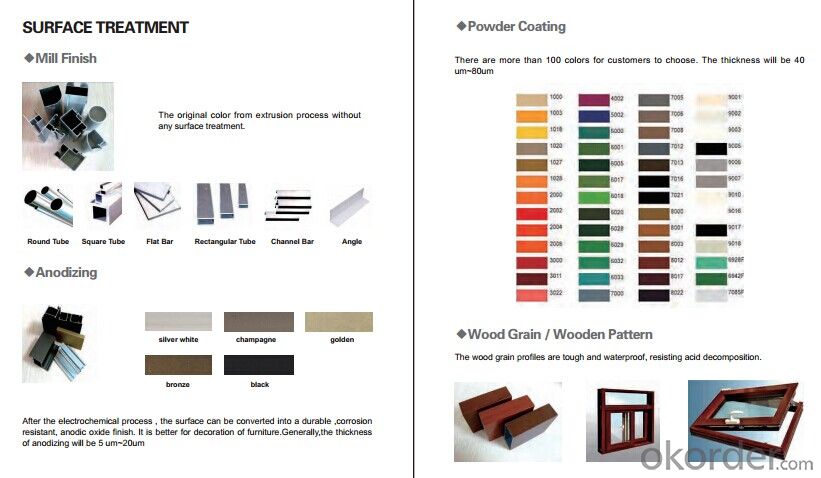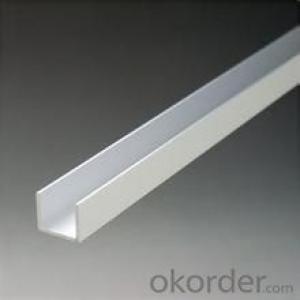Alu profile Section H cable tray
- Loading Port:
- China Main Port
- Payment Terms:
- TT OR LC
- Min Order Qty:
- -
- Supply Capability:
- -
OKorder Service Pledge
OKorder Financial Service
You Might Also Like
Aluminium is a relatively soft,durable, lightweight, ductile and malleablemetal with appearance ranging from silvery to dull gray,depending on the surface roughness. It is nonmagnetic and does not easilyignite. A fresh film of aluminium serves as a good reflector (approximately92%) of visible light and an excellent reflector (as much as98%) of medium and far infrared radiation. The yield strength of pure aluminium is 7–11 MPa,while aluminium alloys have yield strengths ranging from200 MPa to 600 MPa. Aluminium has about one-third the density and stiffnessof steel. It iseasily machined,cast, drawn and extruded.
Alu Profile:
Material | Alloy 6063,6061,6005or according to customer’s choice |
Temper | T3, T4, T5, T6 |
Surface | Anodize, electrophoresis, powder coating, PVDF coating, wood grain painting, matted, etc. |
Length | Coating 6.5 meters, Anodizing 6.5 meters, Mill finish 5 meters |
Application | Industrial, electrical equipment(TV set, air conditioner, refrigerator, computer), decoration,construction, transportation |
Custom Made | We can package following with customer's request. |



FAQ:
1. What is the form of payment?
Normally 30% TT, L/C at sight
2. Type of quotation?
FOB, CFR, CIF
3. Port of loading?
Guangzhou/Shenzhen port
4. Delivery time?
15-20 days after client’s deposit
- Q:Can aluminum profiles be used in solar panel installations?
- Yes, aluminum profiles can be used in solar panel installations. Aluminum is a lightweight and durable material that is commonly used in the construction of solar panel frames. It offers excellent corrosion resistance and can withstand outdoor environmental conditions, making it suitable for long-term use in solar installations. Additionally, aluminum profiles can be easily fabricated and customized to fit specific panel sizes and mounting requirements.
- Q:Can someone give me a direction? Thank you
- Look where you are and where you are. There are various directions for development, such as bags and so on, bathroom..
- Q:Can aluminum profiles be used for electrical busbars?
- Yes, aluminum profiles can be used for electrical busbars. Aluminum is a commonly used material for busbars due to its high electrical conductivity, low cost, and lightweight nature. Aluminum profiles provide a reliable and efficient solution for electrical distribution in various applications, including power distribution systems, switchboards, and control panels. They offer good thermal conductivity, which helps in dissipating heat generated during high current flow. However, it is important to consider factors such as current carrying capacity, mechanical strength, and electrical insulation requirements while selecting aluminum profiles for busbar applications.
- Q:What are the different types of hinges used with aluminum profiles?
- There are several types of hinges commonly used with aluminum profiles, including butt hinges, piano hinges, continuous hinges, pivot hinges, and concealed hinges. Each type of hinge offers different features and advantages, allowing for various installation options and movement capabilities when working with aluminum profiles.
- Q:What are the thermal properties of aluminum profiles?
- The thermal properties of aluminum profiles are quite favorable due to the inherent characteristics of aluminum as a metal. Aluminum has a high thermal conductivity, which means it can transfer heat quickly and efficiently. This property makes aluminum profiles ideal for applications that require heat dissipation or thermal management. Moreover, aluminum profiles have a low coefficient of thermal expansion, meaning they expand and contract minimally with changes in temperature. This makes aluminum profiles highly stable and resistant to warping or distortion, even under extreme temperature variations. Additionally, aluminum profiles have a relatively low melting point compared to other metals, making them suitable for applications that involve high operating temperatures. The ability of aluminum to withstand high temperatures without losing its structural integrity further enhances its thermal properties. Furthermore, aluminum profiles exhibit good thermal insulation properties, as they do not conduct heat easily. This makes them suitable for applications that require thermal insulation or the prevention of heat transfer, such as in building and construction or HVAC systems. Overall, the thermal properties of aluminum profiles, including high thermal conductivity, low coefficient of thermal expansion, high melting point, and good thermal insulation, make them highly versatile and widely used in various industries, ranging from automotive and aerospace to electronics and construction.
- Q:How do I cut and shape aluminum profiles?
- In order to cut and shape aluminum profiles, one must possess several tools and techniques. Here is a step-by-step manual to aid you in accomplishing this task: 1. Obtain the required tools: A miter saw or a circular saw equipped with a carbide-tipped blade suitable for aluminum cutting is essential. Additionally, it is advisable to possess a metal file, sandpaper, a deburring tool, and a tape measure. 2. Measure and mark: Utilize a tape measure to determine the desired length of the aluminum profile. Indicate the location where the cut is to be made using a pencil or marker. 3. Secure the aluminum: Firmly place the aluminum profile on a workbench or cutting surface. Utilize clamps or a vice to hold it securely in place, ensuring it remains stationary during the cutting process. 4. Cut the aluminum: Position the saw blade at the marked location and align it perpendicular to the aluminum profile. Initiate the saw and gradually guide it through the aluminum, applying constant pressure. Allow the saw to perform the task without exerting excessive force, as excessive pressure may cause the blade to bind or chip. Exercise caution and wear safety goggles and gloves to shield yourself from any flying debris. 5. Smooth the edges: Following the cut, you may observe sharp or rough edges on the aluminum profile. Employ a metal file or sandpaper to level these edges, ensuring a clean and safe outcome. 6. Deburring: Employ a deburring tool to eliminate any burrs or rough spots remaining from the cutting process. Gently run the tool along the cut edges, applying slight pressure to smoothen them. 7. Shape the aluminum: If shaping the aluminum profile is necessary, numerous methods can be employed. A common technique involves clamping the profile to a workbench and gradually bending it using a hammer or rubber mallet. Alternatively, specialized tools such as a metal brake or bending machine can be utilized for more precise shaping. 8. Final touches: Once the aluminum profile has been cut and shaped, thoroughly clean it to eliminate any debris or metal shavings. Inspect the profile for any imperfections and make necessary adjustments before employing it for the intended application. Remember to exercise proper safety precautions throughout the process, including wearing safety goggles, gloves, and securely fastening the aluminum profile to prevent accidents.
- Q:What are the different types of surface protection for aluminum profiles?
- There are several different types of surface protection options available for aluminum profiles. These options are designed to enhance the durability and aesthetics of the aluminum profiles and provide protection against various environmental factors. 1. Anodizing: Anodizing is one of the most common methods of surface protection for aluminum profiles. It involves creating a protective oxide layer on the surface of the aluminum through an electrochemical process. Anodizing provides excellent corrosion resistance and can be done in various colors. 2. Powder Coating: Powder coating involves applying a dry powder to the surface of the aluminum profiles, which is then cured under heat to form a protective layer. Powder coating offers a wide range of color options, excellent durability, and resistance to scratching, chipping, and fading. 3. Paint: Painting is another option for surface protection of aluminum profiles. It involves applying a liquid paint coating to the surface, which provides both protection and aesthetic enhancement. Paint can be customized in terms of color, texture, and finish, but it may not be as durable as other options. 4. Clear Coating: Clear coating is a transparent protective layer that can be applied to aluminum profiles. It provides a glossy finish while preserving the natural appearance of the aluminum. Clear coating offers protection against corrosion, UV radiation, and other environmental factors. 5. Cladding: Cladding involves covering the aluminum profiles with another material, such as stainless steel or composite panels. This provides additional protection against corrosion and wear, while also adding aesthetic appeal and design versatility. 6. Film/Protective Tape: Applying a temporary film or protective tape to the surface of aluminum profiles can provide short-term protection during transportation, installation, or construction. These films or tapes can be easily removed after use, leaving the aluminum profile intact. Each of these surface protection options has its own advantages and disadvantages, and the choice depends on the specific requirements of the application, desired aesthetics, budget, and expected environmental conditions.
- Q:Aluminum prices are calculated by the meter, or how to quote the ah?
- Yes, for example, today's aluminum price, 10340+ processing fee 4000=14340, in addition to 1000 is equal to 14.34 yuan /KG
- Q:Can aluminum profiles be used in the construction of modular office spaces?
- Yes, aluminum profiles can be used in the construction of modular office spaces. Aluminum profiles are lightweight, durable, and corrosion-resistant, making them an ideal choice for modular construction. They can be easily fabricated into various shapes and sizes, allowing for versatility in design. Additionally, aluminum profiles offer excellent thermal insulation properties and can be easily integrated with other building components, such as glass panels or insulation materials.
- Q:Can aluminum profiles be used in the construction of exhibition stands?
- Yes, aluminum profiles can be used in the construction of exhibition stands. Aluminum profiles are lightweight, durable, and easy to work with, making them a popular choice for building exhibition stands. They can be easily cut, shaped, and assembled to create custom designs that meet the specific requirements of the exhibition. Additionally, aluminum profiles can be powder-coated or anodized to provide a wide range of finishes, enhancing the aesthetic appeal of the exhibition stand. Furthermore, aluminum is resistant to corrosion and can withstand various weather conditions, ensuring the longevity of the exhibition stand. Overall, using aluminum profiles in the construction of exhibition stands offers flexibility, durability, and a sleek appearance.
1. Manufacturer Overview |
|
|---|---|
| Location | |
| Year Established | |
| Annual Output Value | |
| Main Markets | |
| Company Certifications | |
2. Manufacturer Certificates |
|
|---|---|
| a) Certification Name | |
| Range | |
| Reference | |
| Validity Period | |
3. Manufacturer Capability |
|
|---|---|
| a)Trade Capacity | |
| Nearest Port | |
| Export Percentage | |
| No.of Employees in Trade Department | |
| Language Spoken: | |
| b)Factory Information | |
| Factory Size: | |
| No. of Production Lines | |
| Contract Manufacturing | |
| Product Price Range | |
Send your message to us
Alu profile Section H cable tray
- Loading Port:
- China Main Port
- Payment Terms:
- TT OR LC
- Min Order Qty:
- -
- Supply Capability:
- -
OKorder Service Pledge
OKorder Financial Service
Similar products
New products
Hot products
Related keywords






























